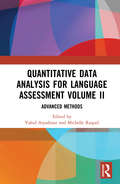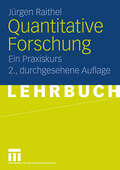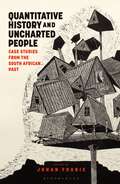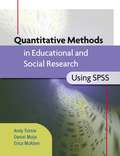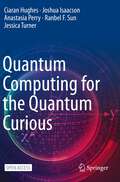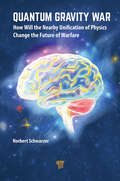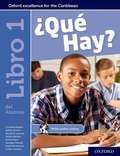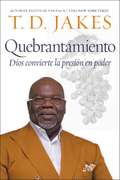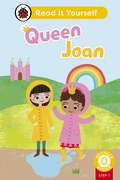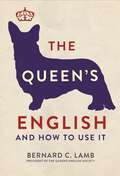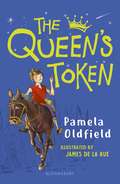- Table View
- List View
Quantitative Data Analysis for Language Assessment Volume II: Advanced Methods
by Vahid Aryadoust Michelle RaquelQuantitative Data Analysis for Language Assessment Volume II: Advanced Methods demonstrates advanced quantitative techniques for language assessment. The volume takes an interdisciplinary approach and taps into expertise from language assessment, data mining, and psychometrics. The techniques covered include Structural Equation Modeling, Data Mining, Multidimensional Psychometrics and Multilevel Data Analysis.Volume II is distinct among available books in language assessment, as it engages the readers in both theory and application of the methods and introduces relevant techniques for theory construction and validation. This book is highly recommended to graduate students and researchers who are searching for innovative and rigorous approaches and methods to achieve excellence in their dissertations and research. It is also a valuable source for academics who teach quantitative approaches in language assessment and data analysis courses.
Quantitative Data Analysis in Education: A Critical Introduction Using SPSS
by Paul ConnollyThis book provides a refreshing and user-friendly guide to quantitative data analysis in education for students and researchers. It assumes absolutely no prior knowledge of quantitative methods or statistics. Beginning with the very basics, it provides the reader with the knowledge and skills necessary to be able to undertake routine quantitative data analysis to a level expected of published research. Rather than focusing on teaching statistics through mathematical formulae, the book places an emphasis on using SPSS to gain a real feel for the data and an intuitive grasp of the main concepts and techniques involved. Drawing extensively upon up-to-date and relevant examples, the reader will be encouraged to think critically about quantitative research and its potential as well as its limitations in relation to education. Packed with helpful features, this book: provides illustrated step-by-step guides showing how to use SPSS, with plenty of exercises to encourage the reader to practice and consolidate their new skills makes extensive use of real-life educational datasets derived from national surveys in the US and UK to illustrate key points and to bring the material to life has a companion website that contains all of the educational datasets used in the book to download as well as comprehensive answers to exercises and a range of other useful resources that are regularly updated. The book will therefore appeal not only to undergraduate and postgraduate students but also to more established and seasoned educational researchers and lecturers and professors who have tended to avoid or shy away from quantitative methods.
Quantitative Data Analysis in Education: A Critical Introduction Using SPSS
by Paul ConnollyThis book provides a refreshing and user-friendly guide to quantitative data analysis in education for students and researchers. It assumes absolutely no prior knowledge of quantitative methods or statistics. Beginning with the very basics, it provides the reader with the knowledge and skills necessary to be able to undertake routine quantitative data analysis to a level expected of published research. Rather than focusing on teaching statistics through mathematical formulae, the book places an emphasis on using SPSS to gain a real feel for the data and an intuitive grasp of the main concepts and techniques involved. Drawing extensively upon up-to-date and relevant examples, the reader will be encouraged to think critically about quantitative research and its potential as well as its limitations in relation to education. Packed with helpful features, this book: provides illustrated step-by-step guides showing how to use SPSS, with plenty of exercises to encourage the reader to practice and consolidate their new skills makes extensive use of real-life educational datasets derived from national surveys in the US and UK to illustrate key points and to bring the material to life has a companion website that contains all of the educational datasets used in the book to download as well as comprehensive answers to exercises and a range of other useful resources that are regularly updated. The book will therefore appeal not only to undergraduate and postgraduate students but also to more established and seasoned educational researchers and lecturers and professors who have tended to avoid or shy away from quantitative methods.
Quantitative Forschung: Ein Praxiskurs
by Jürgen RaithelAlle angehenden Sozialwissenschaftlerinnen und Sozialwissenschaftler benötigen grundlegende Kenntnisse und praxisorientierte Übung in den Methoden quantitativer Sozialforschung. Dieses anwendungsorientierte Lehrbuch führt in den erforderlichen Schritten in die Grundfragen empirischer Sozialforschung ein und erläutert den Forschungsprozess in allen Phasen seiner Entwicklung. Im Zentrum stehen vielfältige Beispiele aus der sozialwissenschaftlichen Praxis und die Analyse und Übersetzung von Daten mit SPSS.
Quantitative Forschung: Ein Praxiskurs
by Jürgen RaithelAlle angehenden Sozialwissenschaftlerinnen und Sozialwissenschaftler benötigen grundlegende Kenntnisse und praxisorientierte Übung in den Methoden quantitativer Sozialforschung. Dieses anwendungsorientierte Lehrbuch führt in den erforderlichen Schritten in die Grundfragen empirischer Sozialforschung ein und erläutert den Forschungsprozess in allen Phasen seiner Entwicklung. Im Zentrum stehen vielfältige Beispiele aus der sozialwissenschaftlichen Praxis und die Analyse und Übersetzung von Daten mit SPSS.
Quantitative History and Uncharted People: Case Studies from the South African Past
by Johan FourieOne of the biggest challenges in the study of history is the unreliable nature of traditional archival sources which omit histories of marginalised groups. This book makes the case that quantitative history offers a way to fill these gaps in the archive. Showcasing 13 case studies from the South African past, it applies quantitative sources, tools and methods to social histories from below to uncover the experiences of unchartered peoples. Examining the occupations of slaves, victims of the Spanish flu, health of schoolchildren and more, it shows how quantitative tools can be particularly powerful in regions where historical records are preserved, but questions of bias and prejudice pervade. Applying methods such as GIS mapping, network analysis and algorithmic matching techniques it explores histories of indigenous peoples, women, enslaved peoples and other groups marginalised in South African history. Connecting quantitative sources and new forms of data interpretation with a narrative social history, this book offers a fresh approach to quantitative methods and shows how they can be used to achieve a more complete picture of the past.
Quantitative History and Uncharted People: Case Studies from the South African Past
One of the biggest challenges in the study of history is the unreliable nature of traditional archival sources which omit histories of marginalised groups. This book makes the case that quantitative history offers a way to fill these gaps in the archive. Showcasing 13 case studies from the South African past, it applies quantitative sources, tools and methods to social histories from below to uncover the experiences of unchartered peoples. Examining the occupations of slaves, victims of the Spanish flu, health of schoolchildren and more, it shows how quantitative tools can be particularly powerful in regions where historical records are preserved, but questions of bias and prejudice pervade. Applying methods such as GIS mapping, network analysis and algorithmic matching techniques it explores histories of indigenous peoples, women, enslaved peoples and other groups marginalised in South African history. Connecting quantitative sources and new forms of data interpretation with a narrative social history, this book offers a fresh approach to quantitative methods and shows how they can be used to achieve a more complete picture of the past.
Quantitative Measures of Mathematical Knowledge: Researching Instruments and Perspectives (Routledge Research in Education #43)
by Jonathan D. Bostic Erin E. Krupa Jeffrey C. ShihThe aim of this book is to explore measures of mathematics knowledge, spanning K-16 grade levels. By focusing solely on mathematics content, such as knowledge of mathematical practices, knowledge of ratio and proportions, and knowledge of abstract algebra, this volume offers detailed discussions of specific instruments and tools meant for measuring student learning. Written for assessment scholars and students both in mathematics education and across educational contexts, this book presents innovative research and perspectives on quantitative measures, including their associated purpose statements and validity arguments.
Quantitative Measures of Mathematical Knowledge: Researching Instruments and Perspectives (Routledge Research in Education #43)
by Jonathan Bostic Erin Krupa Jeffrey ShihThe aim of this book is to explore measures of mathematics knowledge, spanning K-16 grade levels. By focusing solely on mathematics content, such as knowledge of mathematical practices, knowledge of ratio and proportions, and knowledge of abstract algebra, this volume offers detailed discussions of specific instruments and tools meant for measuring student learning. Written for assessment scholars and students both in mathematics education and across educational contexts, this book presents innovative research and perspectives on quantitative measures, including their associated purpose statements and validity arguments.
Quantitative Methods in Educational and Social Research using SPSS (UK Higher Education OUP Humanities & Social Sciences Education OUP)
by Andy Tolmie Daniel Muijs Erica McateerQuantitative Methods in Educational and Social Research Using SPSS bridges the gap between introductory and advanced volumes on quantitative methods. Central to the text is an emphasis on the concept of modelling at the core of data analysis.The implications of the modelling approach are taken all the way back to the stages of research design and sampling, and use of simple descriptive statistics. Using this as a lens the book then moves on to explain carefully a full range of statistical techniques from basic procedures such as correlation and analysis of variance, to advanced methods such as multiple regression, path analysis and multilevel modelling.Key features of the book include:Crucial points illustrated by getting readers to work through key theoretical and analytical tasksA CD that offers step by step guidance on the use of SPSS and example analyses for each of the methods covered by the textClear explanation of the conceptual background to all the analytical techniques included in the bookA range of example datasetsThe aim throughout is to help you gain a fully-grounded conceptual grasp of different techniques, allowing you to apply these thoughtfully, as well as helping you progress towards a more advanced understanding through a step-by-step approach.This book is for you if you are a student or researcher in education or a related field and want an introductory resource that helps you get up to speed quickly.
Quantitative Methods in Educational Research: The Role of Numbers Made Easy
by Stephen GorardThis is a comprehensive guide to quantitative research, rooted in the author's own teaching and research. In particular, it challenges both the student who "does not do numbers" and the student who does nothing but numbers (and who therefore fails to interpret or challenge his/her results). The book shows how all educational researchers need to "do" quantitative research, even if only in the sense of reading other people's research findings. In fact, the book argues that the conventional distinction between primary and secondary research data is inadequate, since there is enormous need/opportunity for conducting research through using and reinterpreting secondary data. This leads to one of the main selling points of the book - Gorard's idea of the "idle researcher", who makes valuable contributions to the research literature by using data gathered by other researchers.
Quantitative Methods in Social Science Research
by Stephen GorardThis clever scheme builds on Gorard's previous book, Quantitative Methods in Educational Research. He has revised the original book in the light of experience and feedback, and has reworked it so that it includes more social science examples. Four chapters are entirely new.
Quantitative Reasoning in Mathematics and Science Education (Mathematics Education in the Digital Era #21)
by Gülseren Karagöz Akar İsmail Özgür Zembat Selahattin Arslan Patrick W. ThompsonThis book focuses on quantitative reasoning as an orienting framework to analyse learning, teaching and curriculum in mathematics and science education. Quantitative reasoning plays a vital role in learning concepts foundational to arithmetic, algebra, calculus, geometry, trigonometry and other ideas in STEM. The book draws upon the importance of quantitative reasoning and its crucial role in education. It particularly delves into quantitative reasoning related to the learning and teaching diverse mathematics and science concepts, conceptual analysis of mathematical and scientific ideas and analysis of school mathematics (K-16) curricula in different contexts. We believe that it can be considered as a reference book to be used by researchers, teacher educators, curriculum developers and pre- and in-service teachers.
Quantitative Reasoning in the Context of Energy and Environment: Modeling Problems in the Real World
by Robert Mayes James MyersThis book provides professional development leaders and teachers with a framework for integrating authentic real-world performance tasks into science, technology, engineering, and mathematics (STEM) classrooms. We incorporate elements of problem-based learning to engage students around grand challenges in energy and environment, place-based leaning to motivate students by relating the problem to their community, and Understanding by Design to ensure that understanding key concepts in STEM is the outcome. Our framework has as a basic tenet interdisciplinary STEM approaches to studying real-world problems. We invited professional learning communities of science and mathematics teachers to bring multiple lenses to the study of these problems, including the sciences of biology, chemistry, earth systems and physics, technology through data collection tools and computational science modeling approaches, engineering design around how to collect data, and mathematics through quantitative reasoning. Our goal was to have teachers create opportunities for their students to engage in real-world problems impacting their place; problems that could be related to STEM grand challenges demonstrating the importance and utility of STEM. We want to broaden the participation of students in STEM, which both increases the future STEM workforce, providing our next generation of scientists, technologists, engineers, and mathematicians, as well as producing a STEM literate citizenry that can make informed decisions about grand challenges that will be facing their generation. While we provide a specifi c example of an interdisciplinary STEM module, we hope to do more than provide a single fish. Rather we hope to teach you how to fish so you can create modules that will excite your students.
Quantum Computing for the Quantum Curious
by Jessica Turner Ciaran Hughes Joshua Isaacson Anastasia Perry Ranbel F. SunThis open access book makes quantum computing more accessible than ever before. A fast-growing field at the intersection of physics and computer science, quantum computing promises to have revolutionary capabilities far surpassing “classical” computation. Getting a grip on the science behind the hype can be tough: at its heart lies quantum mechanics, whose enigmatic concepts can be imposing for the novice. This classroom-tested textbook uses simple language, minimal math, and plenty of examples to explain the three key principles behind quantum computers: superposition, quantum measurement, and entanglement. It then goes on to explain how this quantum world opens up a whole new paradigm of computing. The book bridges the gap between popular science articles and advanced textbooks by making key ideas accessible with just high school physics as a prerequisite. Each unit is broken down into sections labelled by difficulty level, allowing the course to be tailored to the student’s experience of math and abstract reasoning. Problem sets and simulation-based labs of various levels reinforce the concepts described in the text and give the reader hands-on experience running quantum programs. This book can thus be used at the high school level after the AP or IB exams, in an extracurricular club, or as an independent project resource to give students a taste of what quantum computing is really about. At the college level, it can be used as a supplementary text to enhance a variety of courses in science and computing, or as a self-study guide for students who want to get ahead. Additionally, readers in business, finance, or industry will find it a quick and useful primer on the science behind computing’s future.
Quantum Gravity War: How Will the Nearby Unification of Physics Change the Future of Warfare
by Norbert SchwarzerImagine a civilization with a technology so powerful that a single push of the “wrong” button could destroy this very entire civilization. As the consideration of future warfare requires the inclusion of a unified physics, we have to deal with complex concepts of Quantum Theory and General Theory of Relativity. The two have to be brought together before we are able to deal with the matter of future warfare technology in a satisfactory manner. That such a “Theory of Everything” or “Theory of Quantum Gravity”—in principle—already exists and had been already derived by the great German mathematician David Hilbert. When digging deeper and looking for applications of the “new” theory, we realized that many of the new possibilities could also lead to quite disastrous utilizations in military. It is futile to hope that mankind would not recognize this potential and restrain itself from its exploitation.Thus, we thought we better make this knowledge public and hope for some kind of global understanding, perhaps guaranteeing the non-usage of certain technologies. It might only be a weak hope, but in observing history and realizing how little we gained by keeping crucial knowledge restricted to some, thereby often only even more provoking the development of the most horrific weapons one could imagine at the time, we simply see no better way. This book does not provide blueprints ready to start the developments of new quantum gravity weaponry and strategies, but it draws the line that would suffice to awake the right forces and trigger the best developments … before the bad guys get the gist.
Quantum Gravity War: How Will the Nearby Unification of Physics Change the Future of Warfare
by Norbert SchwarzerImagine a civilization with a technology so powerful that a single push of the “wrong” button could destroy this very entire civilization. As the consideration of future warfare requires the inclusion of a unified physics, we have to deal with complex concepts of Quantum Theory and General Theory of Relativity. The two have to be brought together before we are able to deal with the matter of future warfare technology in a satisfactory manner. That such a “Theory of Everything” or “Theory of Quantum Gravity”—in principle—already exists and had been already derived by the great German mathematician David Hilbert. When digging deeper and looking for applications of the “new” theory, we realized that many of the new possibilities could also lead to quite disastrous utilizations in military. It is futile to hope that mankind would not recognize this potential and restrain itself from its exploitation.Thus, we thought we better make this knowledge public and hope for some kind of global understanding, perhaps guaranteeing the non-usage of certain technologies. It might only be a weak hope, but in observing history and realizing how little we gained by keeping crucial knowledge restricted to some, thereby often only even more provoking the development of the most horrific weapons one could imagine at the time, we simply see no better way. This book does not provide blueprints ready to start the developments of new quantum gravity weaponry and strategies, but it draws the line that would suffice to awake the right forces and trigger the best developments … before the bad guys get the gist.
Quark's Academy
by Catherine PelosiSCIENCE IN PROGRESS - ENTER AT YOUR OWN RISK!Junior science geniuses Augustine, Celeste and Oscar can't believe their luck when they're accepted into an elite and mysterious science academy summer camp run by the elusive Inventor Quark.From the moment they step inside the gates of Quark's Academy at the end of Molecule Drive, they know they're in for a week they'll never forget. But things at the academy are not quite what they seem, and the three quickly realise that they'll need to put their squabbles aside and their heads together if they're ever to get out of there alive...A page-turning adventure for readers aged eight to twelve, QUARK'S ACADEMY is bound to cause a hair-raising reaction!'an engaging and entertaining debut for readers aged eight and up with an interest in STEM - or those who just love a well-paced adventure story with fantastical elements.' 4.5 stars - BOOKS + PUBLISHING
Quartier macht Schule: Die Perspektive der Kinder (Sozialraumforschung und Sozialraumarbeit)
by Caroline Fritsche Peter Rahn Christian ReutlingerAus einer kindzentrierten Perspektive wird in diesem Buch die Bedeutung des Sozialraums Schule als Aneignungs- und Ermöglichungsraum am Beispiel zweier Quartiere in einer mittelgroßen Stadt der Schweiz rekonstruiert. Anlass des Forschungsprojektes war die Erfahrung der Stadt, dass in der Quartiersentwicklung der Einbezug von Schulen als System und als konkretes Schulhaus auf unterschiedliche Schwierigkeiten gestoßen ist. Diese Schwierigkeiten verweisen jedoch auf eine generelle Fragestellung: Wie nehmen Kinder ihre Schule und ihr Quartier wahr und welche Beziehungen bestehen zwischen diesen zwei Welten? Auf der Grundlage der empirischen Ergebnisse werden Perspektiven für Schul- und Quartierentwicklung, sowie für Bildungs- und Steuerungspolitik ausgelotet.
Que Hay: Libro Del Alumno 1
by Christine Haylett Jeffrey Britton Margaret Leacock Yorley Mendez Georgia Pinnock Angie Ramnarine Lesbia Tesorero?Que Hay? is the market-leading Spanish course for 11-14-year-olds across the Caribbean. Newly updated, it is as relevant and lively as ever. This comprehensive course follows an immersive approach that encourages students to enjoy and fully engage with both the language and the culture.
Quebrantamiento: Cuando Dios convierte la presión en poder
by T. D. JakesFollow God's process for growth and find hope in life's darkest moments with Bishop T.D. Jakes' uplifting stories and advice from his own faith journey.In this insightful book, #1 New York Times bestselling author T.D. Jakes wrestles with age-old questions: Why do the righteous suffer? Where is God in all the injustice?In his most personal offering yet, Bishop Jakes tells crushing stories from his own journey -- the painful experience of learning his young teenage daughter was pregnant, the agony of watching his mother succumb to Alzheimer's, and the shock and helplessness he felt when his son had a heart attack.Bishop Jakes wants to show you how God uses difficult, crushing experiences to prepare you for unexpected blessings. If you are faithful through suffering, you will be surprised by God's joy, comforted by His peace, and fulfilled with His purpose.Crushing will inspire you to have hope, even in your most difficult moments. If you trust in God and lean on Him during setbacks, He will lead you through.
Queen Joan (Read It Yourself)
by LadybirdTwo stories that build on the phonics learned in previous steps and focus on the sound and letter combinations: ai, ee, oa, oo (long), oo (short).Queen Joan is from Beginner Reader Level 0 and is ideal for children aged from 4+ who are developing their phonics and early reading skills.Each book has been carefully checked by educational and subject consultants and includes comprehension puzzles, book band information, and tips for helping children with their reading.With five levels to take children from first phonics to fluent reading and a wide range of different stories and topics for every interest, Read It Yourself helps children build their confidence and begin reading for pleasure.
Queen of the Moon: Phase 3 Set 2 (Big Cat Phonics for Little Wandle Letters and Sounds Revised)
by Liz Miles Illustrated by Alida Massari Prepared for publication by Collins Big CatBig Cat Phonics for Little Wandle Letters and Sounds Revised has been developed in collaboration with Wandle Learning Trust and Little Sutton Primary School. It comprises classroom resources to support the SSP programme and a range of phonic readers that together provide a consistent and highly effective approach to teaching phonics. It's hard living on the moon, even for a queen. After years of nothing but rocks she's had enough! Now she's searching for somewhere new, but will she find a better home?
The Queen's English: And How to Use It
by Bernard C. Lamb'Having been asked many times if he could recommend a definitive guide to use of our glorious language and not satisfied that the right book existed, Lamb wrote it himself' - Yorkshire PostWritten by the President of the Queen’s English Society and covering all of the basics, this clear and practical guide will teach anyone how to write and use English correctly.What is good English, and why do we need it? The Queen's English shows how the English language, used properly, has great power to instruct, move and entertain people, but used incorrectly, can lead to a lack of clarity and confusion.This book informs in a light-hearted way, reminding readers how to use the basics of grammar, punctuation and spelling, as well as further teaching them new tips and tricks of style, rhetoric, vocabulary and the use of foreign phrases, to give their writing and speech a stylish and impressive flair.The book also shows the perils of using language incorrectly, offering extremely (if unintentionally) humorous examples of where bad English can cause one thing to mean something entirely different!Authoritative yet entertaining, and illustrated with pithy drawings, this is the ideal book for anyone who strives for clear, stylish and accurate communication.
The Queen's Token: A Bloomsbury Reader (Bloomsbury Readers)
by Pamela OldfieldA historical adventure set in Tudor times, perfect for fans of Terry Deary and Philip Ardagh's The Secret Diary series.Hal has a dream: to work as a gardener in King Henry's palace in Whitehall. But they say the king has a terrible temper and when Hal stumbles upon a royal party, he'll have to find a way to prove to the king that he's not a spy. And if he doesn't, well, let's just say that Hal may never live to see his dream come true...This historical tale set in Tudor times, from well-loved author Pamela Oldfield, has inviting black-and-white illustrations by James de la Rue and is perfect for children who are developing as readers.The Bloomsbury Readers series is packed with brilliant books to get children reading independently in Key Stage 2, with book-banded stories by award-winning authors like double Carnegie Medal winner Geraldine McCaughrean and Waterstones Prize winner Patrice Lawrence covering a wide range of genres and topics. With charming illustrations and online guided reading notes written by the Centre for Literacy in Primary Education (CLPE), this series is ideal for reading both in the classroom and at home. For more information visit www.bloomsburyguidedreading.com.Book Band: BrownIdeal for ages 7+
